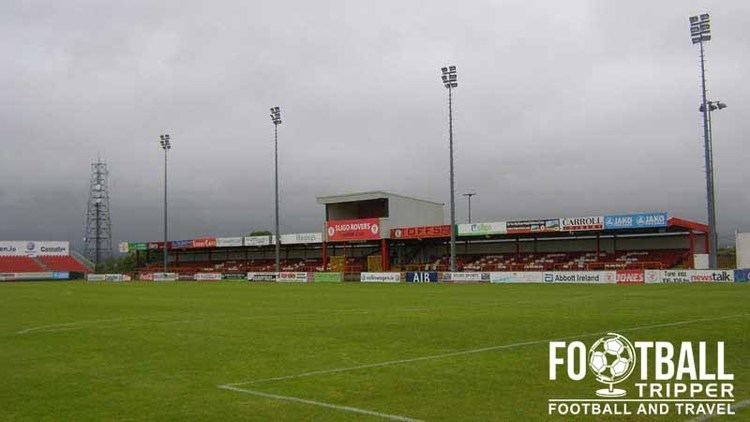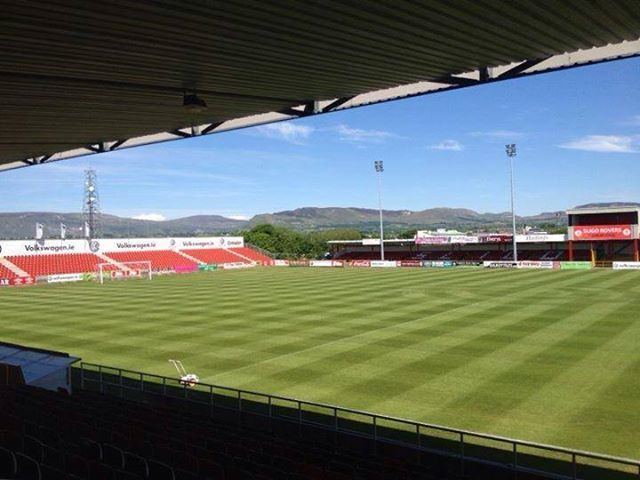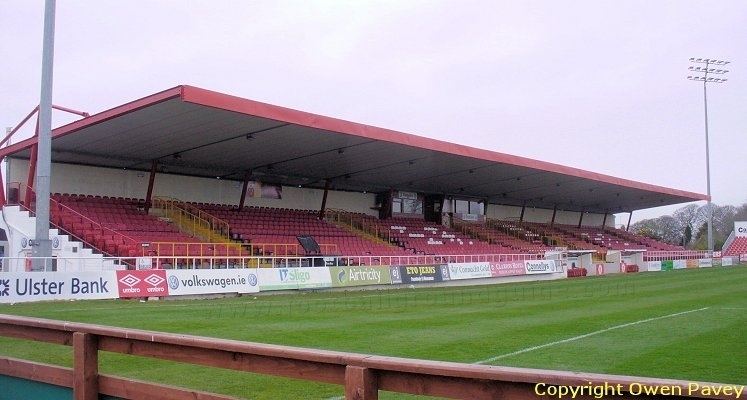Location Sligo, County Sligo Record attendance 13,908 Opened 1928 Team Sligo Rovers F.C. | Owner Sligo Rovers Trust Surface Grass Capacity 5,500 Renovated 2012 | |
 | ||
Full name The Showgrounds, Sligo Town Public transit Sligo Mac Diarmada railway station Similar United Park, Carlisle Grounds, Richmond Park, Finn Park, Turners Cross | ||
The Showgrounds is a stadium in Sligo, which has been home of League of Ireland side Sligo Rovers since the club was formed in 1928.
Contents

Overview

The Showgrounds was leased until 1968 when it was then purchased for Sligo Rovers by a trust foundation representing the people of Sligo. Under the terms of the purchase it can never be mortgaged, sold or used for any commercial purposes other than sport and leisure. The Showgrounds is a 12 acre (49,000 m²) site with the stadium capacity around 5,500 with 4,000 seats.

On the 8th of November 1978 Sligo opened their new covered accommodation on the Jinks Avenue in a FAI League Cup semi final against Shamrock Rovers.

In November 2001 the new main stand was opened to the public for the League Cup fixture with St. Patrick's Athletic. The stand accommodates 1,853 seats, although there is available capacity for further seating. It has been built in cantilever style to ensure there is no obstructed view.

The Showgrounds was revamped in winter 2006 with the demolition of the ground's most famous "Shed". This was followed by the demolition of the ground's old famous turnstiles. New state of the art turnstiles were built along with front offices. In March 2009 work was finished on a new club shop which is open on match nights. This is situated on the Tracey Avenue Stand side.

In May 2009 the Showgrounds had some major upgrading work done to enable the club compete in 2009-10 UEFA Europa League. This work included the building of a new fully tarred car park, along with upgrading work to both all seater stands. An extra 200 seats were added to the Red Stand and also new seating was put into the jinks side of the ground. This work has brought the seating capacity of the ground up to 2,700 which was required for competing in Europa League.
In July 2012 a new stand was completed at the Railway End consisting of 1,300 seats.
History
Most club's histories are focused on the team's quest for silverware but in Sligo it is a bit different. Central to the history of Sligo Rovers is the story of the Showgrounds, and there is a special association and affinity between our supporters and this famous old ground. The Showgrounds takes its name from the annual show held at the grounds by the County Sligo Agricultural Society, the first one held in 1908. Soccer was played in Sligo Town in the 1880s; Fiona Gallagher’s History The Streets of Sligo tells of a game played at this time between the Lancashire Regiment stationed at the Military Barracks and the "Hare and Hounds" Club, the match being played in a field close to the present Showgrounds. In 1928 Sligo Town amalgamated with Sligo Blues to become Sligo Rovers, and the Showgrounds became their home. Over 80 years later, the ground has had its share of drama and excitement – the club’s first league success in 1937, Straka’s famous penalty against Shamrock Rovers in 1955, to the memorable Cup and League campaigns of the last thirty years. But what makes the Showrounds so special to the current generation of supporters is the realization that it was nearly lost to the club.
Brendan Byrne recalls the sequence of events which led to the securing of the Showgrounds: "The first complication was that the Showgrounds was divided between two estates, so we were dealing with the two owners." The Fowler estate ran from Tracey Avenue to an area around the current Jinks Avenue Stand. The remainder of the ground was in the ownership of the Campbell estate. In early 1968 the lease of the Fowler had expired. The members of the Supporters Club met with the Management Committee and discussed the situation that was unfolding. Alderman John Fallon was Chairman of Sligo Rovers and Jimmy Gilmartin was Club Secretary. "Having discussed the problem, the Management Committee appointed four people to travel to Kilkenny to meet with Miss Fowler’s Secretary."
Brendan recalls: "On our way to Kilkenny we talked about possible scenarios and expected that this would be the first of a series of meetings. It was really a journey into the unknown. At the meeting with Miss Fowler’s Solicitor, John Fallon and Jimmy Gilmartin outlined the history of the Showgrounds and Sligo Rovers. They explained the close affinity between Sligo Rovers, the Showgrounds and Sligo public. The solicitor took us by surprised when he asked what we were prepared to offer. This was a stage way ahead of what we had anticipated. There followed and uneasy silence, at the end of which we offered £4,000 – a lot of money in 1968. The solicitor said that he would convey our offer to Miss Fowler and after an anxious wait, the news came through three weeks later that our offer was accepted."
Later that summer John Fallon, Paddy Gilmartin and Brendan Byrne met with Charlie Brown at Argue & Phibbs Solicitors, regarding the purchase of the Campbell estate. They agreed a figure of £2,500 on the night. This meant that Sligo Rovers had effectively purchased the Showgrounds. Whilst this was great news, the club was left with the problem of raising £6,500 which was no minor undertaking in 1968. A number of individuals were given different areas of the town, and among these Brendan Byrne recalls being assigned St. Joseph's and St. Brigid's Area. He collected two shillings from several houses on Saturday evenings. Many of those houses could ill-afford this amount, yet they contributed week after week to keep their beloved old Rovers in the Showgrounds. There was a strong bond between Sligo Rovers and the people of that area and this was particularly noticeable among the older people. This weekly collection stretched from 1968 to late 1971 to early 1972. "Looking back, when the Supporters Club met with the Management Committee in early 1968 neither group could have envisaged the significance of that meeting or the legacy it would leave." The Members of the Supporters Club included among others, Albert Higgins, Mick Carroll, Paddy Morahan, Ray Gallagher, Breda Mulligan, Bernie Tiernan, Martin Keaveney, Willie Kelly, Willie Bradley, Tommy McDonagh, Mary Foley, Bertie Conlon, Eugene Conlon and Breda Byrne.
The outcome of that meeting provided Sligo with one of the best football arenas in the country and with secure tenure. In the years that followed, Paddy Morahan led groups of volunteers on works improving the Showgrounds. Paddy’s efforts made an enormous contribution in modernising the ground. Since 2001, the ground has seen the building of the new stand and then the hard work of Geoffrey Rainey, Michael Clancy and a host of other volunteers who have once again helped transform the ground. Meeting the purchase price of the Showgrounds by weekly collectors was time consuming and stretched over three or four years. It did have beneficial side effects that are hard to quantify … it gave people a sense of ownership and belonging which goes to the heart of Sligo Rovers.
This is what sets Sligo Rovers apart from other clubs, the strong community loyalty, the fierce pride people have in their club and the sense of loyalty has passed on through generations of Rovers supporters.Other factors contributed to the unique aura of the Showgrounds – its working class setting in one of Sligo's oldest communities, the sense of the Showgrounds being one of Irish soccer's most resilient outposts. While the facilities have improved over the years, the character of the Showgrounds will never change and it will always retain its special place in the hearts of Sligo Rovers supporters.
Future development
In the future there are plans to demolish the Jinks Avenue Stand and build a new 2,000 seater stand in its place. There are also plans to add a roof to the new Railway End and replace the old shed end with a new stand, though these plans are only in the pipeline.
